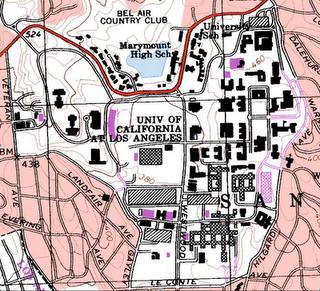View Larger Image:
Station Fire 2009 : Effects on LA County Parks
· “Bone-dry conditions in an area that has not seen a major fire in more than 60 years pushed a Southern California wildfire from 45,000 acres to more than 100,000 acres in a matter of hours Monday, fire officials said” (CNN). August 26, 2009 marked the beginning of the most intense fire Southern California, Los Angeles County specifically, has experienced in almost a century. The Station Fire blazed outward from the Angeles National Forest, located approximately 30 miles NNE of Los Angeles. Late summer in California is one of the most unfavorable environments for a wild fire. Humidity is low, warm Santa Ana winds can reach speeds of sixty knots, and the common chaparral shrubbery has not tasted water since the previous winter or longer.
The Station fire was shaped and guided by these unfortunate conditions. The fire started out as a brush fire, but as it spread North-East towards a more forested area, matters worsened. The innocent brush fire had arrived at the San Gabriel Mountains. “The Station Fire, burning on National Forest lands, is truly a forest fire, especially at the higher elevations of the San Gabriel Mountains where dense stands of timber retain heat despite suppression efforts”(Inciweb). With the Station Fire’s access to the Angeles National Forest, the fuel needed for a record-breaking fire was more than available.
Low humidity, the presence of moderate Santa Ana winds, and now the addition of the forest super fuel made the fire into what it became. The fire started near Mount Lukens and spread North and then East. Since heat rises, the fire stayed mostly at higher elevations. It was lucky that the initial fire made it over the first mountain range because if it had taken a course downward, it could have spread through densely populated areas. Once the fire got a hold of the National Forest, it started to engulf its entirety. With help of the Santa Ana’s, its intensity increased, just as one blows on the kindling to start the camp fire. As the fire weaved through the canyons of the San Gabriel Mountains, it picked up even more speed as a result of the canyons natural wind tendencies. All of these claims can be supported by my topographical reference map illustrated by a DEM hillshade and transparently layered spread of the fire.
The Station Fire affected so many different aspects of central Los Angeles County. Of all of these, I chose to focus on its affect on Los Angeles County’s recreational parks. LA’s parks accommodate millions of visitors a year. These parks are a source of income for many people in LA both directly and indirectly. Not only that but these parks showcase some of California’s greatest beauties. The loss or even temporary loss of these recreational parks would be a true disappointment to the County of Los Angeles. I found that eleven recreational parks were affected by heavy ash deposits and small pockets of brush fires within a ten mile radius surrounding the fire.
Although no recreational parks lie within the marked territory of the fire, there were some parks less than half a mile away. The closest parks were Loma Alta, Charles C. Farnesworth, Charles White, Crescenta Valley, Dexter, and Two Strike Park. The parks proximity to the fire boundary suggests closure and physical damage during the fire. The thickness of ash falling from a 100,000 acre fire can cause great physical damage to a park. The ash dismantles soil composition, deteriorates structures, and leaves an off-putting aesthetic. Besides this, small outbursts from the main fire scorched land in mass quantities within the parks. Until the forest regains strength, foliage turns green, and structures are rebuilt, there will be little to no visitors to these parks.
Bibliography:
CNN. "'Angry fire' roars across 100,000 California acres - CNN." Featured Articles from CNN. N.p., 31 Aug. 2009. Web. 9 June 2011. <http://articles.cnn.com/2009-08-31/us/california.wildfires_1_mike-dietrich-firefighters-safety-incident-commander?_s=PM:US>.
"InciWeb the Incident Information System: Station Fire News Release." InciWeb the Incident Information System: Current Incidents. N.p., 15 Sept. 2009. Web. 9 June 2011. <http://inciweb.org/incident/article/9535/>.
"InciWeb the Incident Information System: Station Fire." InciWeb the Incident Information System: Current Incidents. N.p., 10 Nov. 2009. Web. 9 June 2011. <http://inciweb.org/incident/1856/>.
KTLA News. "Report: Number of Firefighters Reduced Before Station
Fire." KTLA.com. N.p., 2 Oct. 2009. Web. 9 June 2011.
<www.ktla.com/news/landing/
KTLA News. "Station fire is largest in L.A. County's modern history."
Los Angeles Times. N.p., 2 Sept. 2009. Web. 9 June 2011.
<http://latimesblogs.latimes.
Fire." KTLA.com. N.p., 2 Oct. 2009. Web. 9 June 2011.
<www.ktla.com/news/landing/
KTLA News. "Station fire is largest in L.A. County's modern history."
Los Angeles Times. N.p., 2 Sept. 2009. Web. 9 June 2011.
<http://latimesblogs.latimes.














